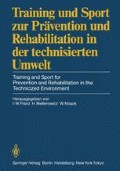Zusammenfassung
Hochleistungstrainierte Ruderer werden auf einem mechanisch gebremsten Ruderergometer mit elektronischer Leistungsanzeige und Messung der spirometrischen Leistungsdaten und Bestimmung der kapillären Lactatkonzentration belastet. Die Probanden unterziehen sich einem Zweistufentest mit einer Vorbelastung und einer Maximalbelastung über 6 Minuten. Nach einer 2-std. Pause erfolgt ein Mehrstufen-test beginnend mit 150 Watt und einer Steigerung um 50 Watt jede 2 min bis zur Ausbelastung.
Der Mehrstufentest differenziert besser die für das Rudern wichtige Aerob-anaerobe Schwelle als ein Zweistufentest. Maximalwerte für Sauerstoffaufnahme und Herzfrequenz werden gleich hoch bestimmt. Mit dieser Leistungsdiagnostik ist eine Trainingsberatung möglich. So findet sich häufig ein Abfall der aeroben Leistungsfähigkeit während der Wettkampfsaison, der teilweise vermieden werden soll. Auch die Vorbereitung vor der Saison kann beurteilt werden.
Summary
Highly trained rowers were tested on a mechanically braked rowing ergometer with a special electronic measuring device; spirometric data and capillary lactate concentrations were also determined.
First a two-stage test is performed. The first stage is an eight minute row at submaximal level; the second stage is a maximum row for six minutes. A multi-stage test, beginning with 150 Watts with an increase in work load of 50 Watts after 2 min up to exhaustion, is conducted after an interval of 2 h. A lactate performance relation is computed and the aerobic/anaerobic threshold is determined for each test. The athlete is examined 4–6 times annually.
There is no good correlation between the AAT in either test. The AAT in the two-stage test depends on the work done in the first stage. The multi-stage test gives a better and more detailed information about the physical performance of the tested rower.
In the examined rower, mostly the best values for endurance and maximal performance were seen before the beginning of the racing season. During the competition months there is more or less a decrease in endurance and maximum power. Improvement of the training is possible by sports-specific exercise testing.
Access this chapter
Tax calculation will be finalised at checkout
Purchases are for personal use only
Preview
Unable to display preview. Download preview PDF.
Literatur
Keul J, Dickhuth HH, Berg A, Lehmann M, Huber G (1981) Allgemeine ünd sportartspezifische Leistungsdiagnostik im Hochleistungsbereich. Leistungssport 11: 382–398
Mader A, Madsen O, Hollmann W (1980) Zur Bedeutung der lactaziden Energiebereitstellung für Trainings-und Wettkampfleistungen im Sportschwimmen. Leistungssport 10:263–279, 408–418; (1977) 8–62
Pendergast D, Leibowitz R, Wilson D, Cerretelli P (1983) The effect of preceeding anaerobic exercise on aerobic and anaerobic work. Eur J Appl Physiol 52: 29–35
Steinacker JM, Marx TR, Thiel U (1983) Konstruktion eines speziellen Leistungsmessers in Digitaltechnik für die Ruderspiroergometri. In: Sport: Leistung und Gesundheit. Dtsch Sportärztekongreß 1982. Dtsch Ärzteverlag, Köln, S 169–173
Steinacker JM, Marx TR, Fiegenbaum FA, Wodick RE (1983) Die Ruderspiroergometrie als eine Methode der sportartspezifischen Leistungsdiagnostik. Dtsch Z Sportmed 34: 333–342
Author information
Authors and Affiliations
Editor information
Editors and Affiliations
Rights and permissions
Copyright information
© 1985 Springer-Verlag Berlin Heidelberg
About this chapter
Cite this chapter
Steinacker, J.M. et al. (1985). Untersuchungen über die Bestimmung der Leistungsfähigkeit von Ruderern mit einem Mehrstufentest und einem Zweistufentest bei der Ruderspiroergometrie. In: Franz, IW., Mellerowicz, H., Noack, W. (eds) Training und Sport zur Prävention und Rehabilitation in der technisierten Umwelt / Training and Sport for Prevention and Rehabilitation in the Technicized Environment. Springer, Berlin, Heidelberg. https://doi.org/10.1007/978-3-642-70301-0_126
Download citation
DOI: https://doi.org/10.1007/978-3-642-70301-0_126
Publisher Name: Springer, Berlin, Heidelberg
Print ISBN: 978-3-642-70302-7
Online ISBN: 978-3-642-70301-0
eBook Packages: Springer Book Archive

